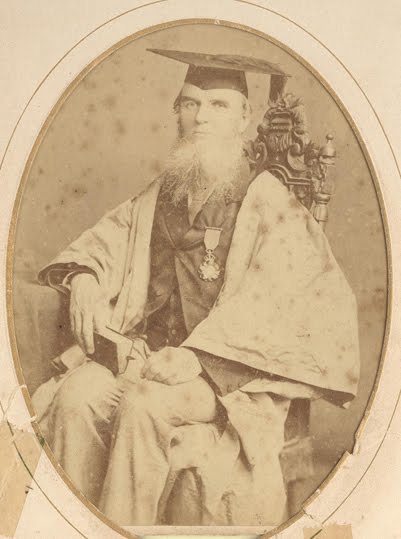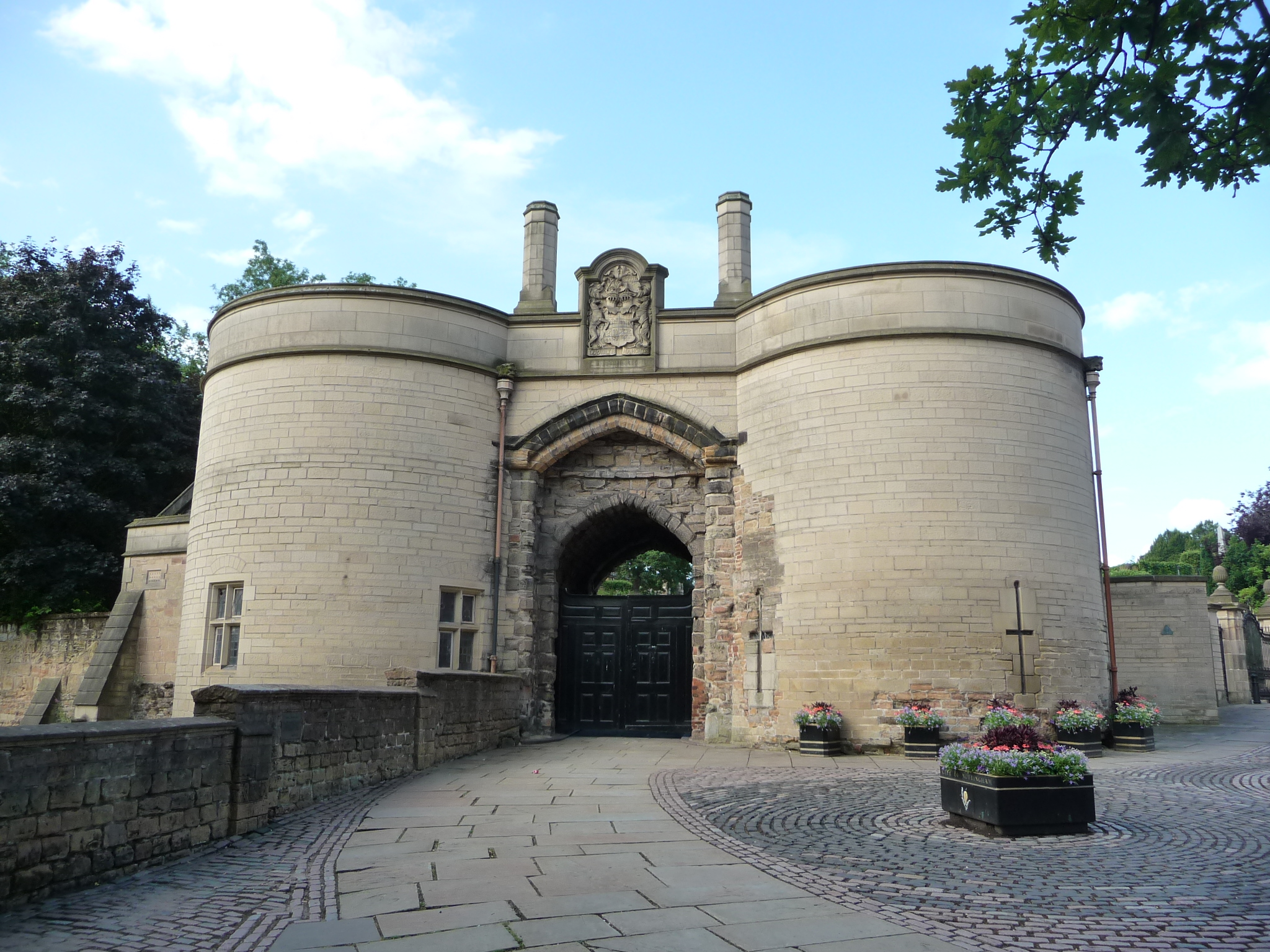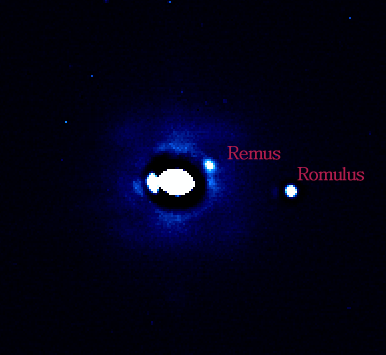|
Norman Robert Pogson
Norman Robert Pogson, CIE (23 March 1829 – 23 June 1891) was an English astronomer who worked in India at the Madras observatory. He discovered several minor planets and made observations on comets. He introduced a mathematical scale of stellar magnitudes with the ratio of two successive magnitudes being the fifth root of one hundred (~2.512) and referred to as Pogson's ratio. Youth and education Norman was born in Nottingham, the son of George Owen Pogson, a hosiery manufacturer, lace dealer and commission agent, "with enough income to support an extended family", and his wife, Mary Ann. It was intended that he should follow his father into business, and he was accordingly sent for "commercial education", but he was fascinated by science, and his mother supported and encouraged this interest. His early education was largely informal. He left school at 16, intending to teach mathematics. At the age of eighteen, he calculated with the help of John Russell Hind of the Royal ... [...More Info...] [...Related Items...] OR: [Wikipedia] [Google] [Baidu] |
Nottingham
Nottingham ( , East Midlands English, locally ) is a City status in the United Kingdom, city and Unitary authorities of England, unitary authority area in Nottinghamshire, East Midlands, England. It is located south-east of Sheffield and north-east of Birmingham. Nottingham is the legendary home of Robin Hood and to the lace-making, bicycle and Smoking in the United Kingdom, tobacco industries. The city is also the county town of Nottinghamshire and the settlement was granted its city charter in 1897, as part of Queen Victoria's Diamond Jubilee celebrations. In the 2021 United Kingdom census, 2021 Census, Nottingham had a reported population of 323,632. The wider conurbation, which includes many of the city's suburbs, has a population of 768,638. It is the largest urban area in the East Midlands and the second-largest in the Midlands. Its Functional Urban Area, the largest in the East Midlands, has a population of 919,484. The population of the Nottingham/Derby metropolitan a ... [...More Info...] [...Related Items...] OR: [Wikipedia] [Google] [Baidu] |
Society For The History Of Astronomy
The Society for the History of Astronomy is an organisation based in the United Kingdom that promotes research into the history of astronomy. It publishes a research journal called ''The Antiquarian Astronomer'' and a regular ''Bulletin''. The society The Society for the History of Astronomy was founded in 2002 to promote the study of the history of astronomy by hosting talks by members and publishing new research into the field. One main objective was to encourage research into past astronomers who have previously been neglected within the history of science. Some of its members are professional historians of science but most are amateur historians. The honorary president is Dr Allan Chapman of Wadham College, Oxford. The honorary vice-presidents are Emily Winterburn (who was chair at the time of foundation) and Prof. Mike Edmunds. Previous vice-presidents have included Sir Patrick Moore, Sir Arnold Wolfendale, FRS, and Dr Michael Hoskin. The society hosts several one-day ... [...More Info...] [...Related Items...] OR: [Wikipedia] [Google] [Baidu] |
Charles Wood, 1st Viscount Halifax
Charles Wood, 1st Viscount Halifax (20 December 1800 – 8 August 1885), known as Sir Charles Wood, 3rd Baronet, between 1846 and 1866, was a British Whigs (British political party), Whig politician and Member of the Parliament. He was Chancellor of the Exchequer from 1846 to 1852, First Lord of the Admiralty from 1855 to 1858, and Secretary of State for India from 1859 to 1866. Background Halifax was the son of Sir Francis Wood, 2nd Baronet of Barnsley, and his wife Anne, daughter of Samuel Buck. He was educated at Eton College, Eton and Oriel College, Oxford, where he studied classics and mathematics. Political career A Liberal Party (UK), Liberal and Member of Parliament from 1826 to 1866, Wood abandoned the seat of Great Grimsby (UK Parliament constituency), Great Grimsby and was returned in 1831 for the pocket borough of Wareham (UK Parliament constituency), Wareham, probably as a paying guest, which arrangement enabled him to remain in London in preparation for the readi ... [...More Info...] [...Related Items...] OR: [Wikipedia] [Google] [Baidu] |
John Lee (astronomer)
John Lee LL.D, FRS (28 April 1783 – 25 February 1866), born John Fiott, was an English philanthropist, astronomer, mathematician, antiquarian, barrister, and numismatist. Family He was the eldest son of John Fiott and Harriet, daughter of William Lee, of Totteridge, MP for Appleby, of the family of the Lee baronets of Hartwell. His father was involved in the family counting house business and was a failed East India merchant. He was orphaned when young and was brought up by his maternal uncle, William Lee Antonie. Education Lee read Mathematics at St John's College, Cambridge between 1802 and 1806, graduating fifth wrangler in his year. He was elected a fellow in 1808. Following his studies from 1807 to 1815 he travelled extensively in the Middle East and Europe as a travelling bachelor. During this time he gained an interest in antiquities. Personal life He took the name Lee in 1816 following the death of his uncle William Lee Antonie in 1815. In 1833 Lee married Cecil ... [...More Info...] [...Related Items...] OR: [Wikipedia] [Google] [Baidu] |
George Airy
Sir George Biddell Airy (; 27 July 18012 January 1892) was an English mathematician and astronomer, as well as the Lucasian Professor of Mathematics from 1826 to 1828 and the seventh Astronomer Royal from 1835 to 1881. His many achievements include work on planetary orbits, measuring the mean density of the Earth, a method of solution of two-dimensional problems in solid mechanics and, in his role as Astronomer Royal, establishing Greenwich as the location of the prime meridian. Biography Airy was born at Alnwick in Northumberland, one of a long line of Airys who traced their descent back to a family of the same name residing at Kentmere, in Westmorland, in the 14th century. The branch to which he belonged, having suffered in the English Civil War, moved to Lincolnshire and became farmers. Airy was educated first at elementary schools in Hereford, and afterwards at Colchester Royal Grammar School. An introverted child, Airy gained popularity with his schoolmates through his grea ... [...More Info...] [...Related Items...] OR: [Wikipedia] [Google] [Baidu] |
Oxford
Oxford () is a City status in the United Kingdom, cathedral city and non-metropolitan district in Oxfordshire, England, of which it is the county town. The city is home to the University of Oxford, the List of oldest universities in continuous operation, oldest university in the English-speaking world; it has buildings in every style of Architecture of England, English architecture since late History of Anglo-Saxon England, Anglo-Saxon. Oxford's industries include motor manufacturing, education, publishing, science, and information technologies. Founded in the 8th century, it was granted city status in 1542. The city is located at the confluence of the rivers Thames (locally known as the Isis) and River Cherwell, Cherwell. It had a population of in . It is north-west of London, south-east of Birmingham and north-east of Bristol. History The history of Oxford in England dates back to its original settlement in the History of Anglo-Saxon England, Saxon period. The name � ... [...More Info...] [...Related Items...] OR: [Wikipedia] [Google] [Baidu] |
245 Vera
245 Vera is a large Main belt asteroid. It was discovered by N. R. Pogson on February 6, 1885, in Madras, and was named at the suggestion of his wife. The asteroid is orbiting the Sun at a distance of with a period of and an eccentricity (ovalness) of 0.19. The orbital plane is tilted at an angle of 5.16° to the plane of the ecliptic. In 1890, Daniel Kirkwood noted that this asteroid shares similar orbital elements with 86 Semele and 106 Dione. Photometric measurements of this asteroid made during 1980–1981 were used to produce a light curve that demonstrated a rotation period of with a brightness variation of in magnitude. It is classified as a stony S-type asteroid in the Tholen system. The asteroid has an estimated diameter of based on near infrared observations. References Further readingThe Asteroid Orbital Elements Database [...More Info...] [...Related Items...] OR: [Wikipedia] [Google] [Baidu] |
107 Camilla
107 Camilla is one of the largest asteroids from the outermost edge of the asteroid belt, approximately in diameter. It is a member of the Sylvia family and located within the Cybele group. It was discovered on 17 November 1868, by English astronomer Norman Pogson at Madras Observatory, India, and named after Camilla, Queen of the Volsci in Roman mythology. The X-type asteroid is a rare triple asteroid with two minor-planet moons discovered in 2001 and 2016, respectively. It is elongated in shape and has a short rotation period of 4.8 hours. Physical characteristics Camilla has a very dark surface and primitive carbonaceous composition. A large number of rotational lightcurves of have been obtained from photometric observations since the 1980s. Best rated results gave a short rotation period of 4.844 hours with a brightness amplitude between 0.32 and 0.53 magnitude. Lightcurve analysis indicates that Camilla's pole most likely points towards ecliptic coordinates ... [...More Info...] [...Related Items...] OR: [Wikipedia] [Google] [Baidu] |
87 Sylvia
87 Sylvia is one of the largest asteroids (approximately tied for 7th place, to within measurement uncertainties). It is the parent body of the Sylvia family and member of Cybele group located beyond the main asteroid belt (see minor-planet groups). Sylvia was the first asteroid known to possess more than one moon. Discovery and naming Sylvia was discovered by N. R. Pogson on 16 May 1866, from Madras (Chennai), India.Pogson, N. R. (1866), Minor Planet (87) Sylvia', Monthly Notices of the Royal Astronomical Society, Vol. 26, p. 311 (June 1866) Antonio Paluzie-Borrell, writing in Paul Herget's ''The Names of the Minor Planets'' (1955), mistakenly states that the name honors Sylvie Petiaux-Hugo Flammarion, the first wife of astronomer Camille Flammarion. In fact, in the article announcing the discovery of the asteroid, Pogson explained that he selected the name in reference to Rhea Silvia, mother of Romulus and Remus (''MNRAS'', 1866). Physical characteristics Sylvia is ve ... [...More Info...] [...Related Items...] OR: [Wikipedia] [Google] [Baidu] |
80 Sappho
80 Sappho (symbol: )is a large, S-type asteroid, S-type (stony) main-belt asteroid. It was discovered by English astronomer Norman Robert Pogson, Norman Pogson on 2 May 1864, and is named after Sappho, the Archaic Greece poet. The asteroid is orbiting the Sun at a distance of with a orbital period, period of 3.48 years and an orbital eccentricity, eccentricity (ovalness) of 0.2. The orbital plane is inclined at an angle of 8.68° to the plane of the ecliptic. 13-cm radar observations of this asteroid from the Arecibo Observatory between 1980 and 1985 were used to produce a diameter estimate of . Hanuš et al. (2013) confirmed the polar axis has ecliptic coordinates = and listed a rotation period of 14.03087 h. Sappho (at apparent magnitude 11.8) Occultation, occulted the magnitude 7.2 star HIP 24403 in the constellation of Taurus (constellation), Taurus on 16 September 2018 at 8:54 UT. Sacramento and Salt Lake City were the two major cities located underneath the sh ... [...More Info...] [...Related Items...] OR: [Wikipedia] [Google] [Baidu] |
67 Asia
67 Asia is a large main belt asteroid. It was discovered by English astronomer N. R. Pogson on April 17, 1861, from the Madras Observatory. Pogson chose the name to refer both to Asia, a figure in Greek mythology, and to the continent of Asia, because the asteroid was the first to be discovered from that continent. This object is orbiting the Sun with a period of , a semimajor axis of , and an eccentricity of 0.185. It has a 2:1 commensurability with Mars, having an orbital period double that of the planet. The orbital plane lies at an inclination of 6.0° to the plane of the ecliptic. This is a stony S-type asteroid with a cross-sectional size of 61 km, Photometry from the Oakley Observatory during 2006 produced a lightcurve that indicated a sidereal rotation period of with an amplitude of in magnitude. References External links * * Background asteroids Asia Asia Asia ( , ) is the largest continent in the world by both land area and po ... [...More Info...] [...Related Items...] OR: [Wikipedia] [Google] [Baidu] |
46 Hestia
46 Hestia is a large, dark main-belt asteroid. It is also the primary body of the Hestia clump, a group of asteroids with similar orbits. Hestia was discovered by N. R. Pogson on August 16, 1857, at the Radcliffe Observatory, Oxford. Pogson awarded the honour of naming it to William Henry Smyth, the previous owner of the telescope used for the discovery. Smyth chose to name it after Hestia, Greek goddess of the hearth. This created a problem in Greek, where 4 Vesta also goes by the name ''Hestia''. The computed Lyapunov time for this asteroid is 30,000 years, indicating that it occupies a chaotic orbit that will change randomly over time because of gravitational perturbations of the planets. Hestia has been studied by radar. 13-cm radar observations of this asteroid from the Arecibo Observatory between 1980 and 1985 were used to produce a diameter estimate of 131 km. In 1988 a search for satellites or dust orbiting this asteroid was performed using the UH88 tele ... [...More Info...] [...Related Items...] OR: [Wikipedia] [Google] [Baidu] |





